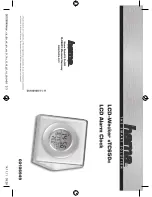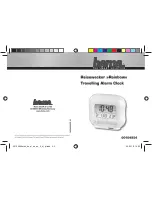
4
Battery
compartment
Bracket
Detector
Test/Silence button
Features
CO ALARM:
The alarm pattern is four (4) short alarm sirens with four (4)
corresponding flashes of the red LED light every five (5) seconds for the initial
four(4) minutes, and after the initial four(4) minutes ,this pattern will repeat every
sixty(60) seconds. This pattern will repeat until the CO event is eliminated. The CO
sensor is designed to detect carbon monoxide gas from ANY source of
combustion. It is NOT designed to detect any other gas.
(Note: This section is for model SCAZB-141 and SCAZB-143)
SMOKE ALARM:
The alarm pattern is three (3) short alarm sirens with three (3)
corresponding flashes of the red LED light. This pattern will repeat until the
smoke event is eliminated. The smoke alarm will take precedence when both
smoke and CO are present.
SILENCE FEATURE:
The silence feature can temporarily quiet the siren for
several minutes, and the LED still flashes according to correspond alarm. You can
silence the Smoke/CO alarm by pressing the Test/Silence button on the
detector. The Smoke alarm will remain silent for up to 8 minutes. After 8 minutes,
if the smoke has not cleared, the siren will be sounding again. The CO alarm will
remain silent for up to 4 minutes. After 4 minutes, if the CO levels remain
dangerous, the siren will be sounding again.
TEST FEATURE:
Please press Test/Silence button to test the Smoke/CO
detector once after the installation is complete, and please test Smoke/CO
detector at least once a week to ensure the detector is working properly.
Pressing the Test/Silence button, the detector will perform two different test
alarm patterns in accordance type of the detector.
•
For SMAZB-141, SMAZB-143:
The test alarm pattern is three (3) short alarm
sirens with three (3) corresponding flashes of the red LED light
•
For SCAZB-141, SCAZB-143:
The test alarm pattern is three (3) short alarm
sirens with three (3) corresponding flashes of the red LED light and then four (4)
short alarm sirens with four (4) corresponding flashes of the red LED light repeat
two (2) cycles.
Figure 8:
Removing the bracket
Figure 9-1:
Mounting the bracket
Figure 9:
Battery compartment
Figure 10:
Test/Silence button location
LOW BATTERY WARNING:
When the batteries are low and need to be replaced,
the device will beep and the yellow LED light will flash once every 50 seconds.
This warning should last for up to 30 days, but please replace the battery asap
before battery power is completely exhausted.
(Note: If your detector is model SMAZB-143 or SCAZB-143, the detector must be
replaced and deactivated immediately. The batteries of these models are not
replaceable)
WARNING:
When disposing of the detector, Please refer to
DEACTIVATION OF
DETECTOR
section to deactivate your detector.
Installing your detector
Read “Locations To Install Your Detector” and “Locations Not To Install Your
Detector” section in this Manual first, then decide where to install a smoke
detector.
Please follow these steps to install your Smoke/CO detector.
1. At the place where you are going to install your Smoke/CO detector, draw a
horizontal line six inches (15 cm) long.
2. Remove the mounting bracket from your unit by rotating it counterclockwise,
shown in Figure 8.
3. Place the bracket so that the two longest hole-slots are aligned on the line. In
each of keyhole slots, drawing a mark to locate a mounting plug and screw.
4. Remove the bracket.
5. Using a 3/16-inch (5mm) drill bit, drills two holes at the marks and insert plastic
wall plugs. Put the smoke detector away from plastic dust on it when you drill
holes for mounting.
6. Using the two screws and plastic wall plugs (all supplied), attach the bracket
to the wall.
7. Battery installation, shown in Figure 9.
(a). Open battery cover
(b). Install battery into compartment and make sure the ”+” and “-“ ends of each
battery are aligned properly.
(c). After battery is replaced, please press test button immediately to check if it
alarms properly.
8. Line up the slot of the bracket and the Smoke/CO detector. Push the
Smoke/CO detector onto the mounting bracket and turn it clockwise to fix it into
place, and when the bracket was installed would activate power for five-year
type (SMAZB-143, SCAZB-143). Pull onward on the Smoke/CO detector to make
sure it is securely attached to the mounting bracket, shown in Figure 9-1.
9. The Smoke/CO detector will start searching (up to 15 minutes) for a Zigbee
network to join.
(a) Make sure that the Zigbee network is open for joining devices and will accept
the Smoke/CO detector.
(b) While the Smoke/CO detector is searching for a Zigbee network to join, the
green LED is flashing.
(c) When the green LED stops flashing, the Smoke/CO detector has successfully
joined the Zigbee network.
10. Please write your install date on attached label of Date of install in the
package, and paste it on obvious place.
The detector is not to be located within 5 feet (1.5m) of any cooking appliance.
In damp or very humid areas, or near bathrooms with showers. Moisture in
humid air can enter the sensing chamber, then turns into droplets upon cooling,
which can cause nuisance alarms. Install smoke detectors at least 10 feet (3
meters) away from bathrooms.
•
In very cold or very hot areas, including unheated buildings or outdoor rooms.
If the temperature goes above or below the operating range of smoke detector,
it will not work properly. The temperature range for your smoke detector is 40
o
F
to 100
o
F (4.4
o
C to 37.8
o
C).
•
In very dusty or dirty areas, dirt and dust can build up on the detector’s sensing
chamber, to make it overly sensitive. Additionally, dust or dirt can block
openings to the sensing chamber and keep the detector from sensing smoke.
•
Near fresh air vents or very drafty areas like air conditioners, heaters or fans,
fresh air vents and drafts can drive smoke away from smoke detectors.
•
Dead air spaces are often at the top of a peaked roof, or in the corners between
ceilings and walls. Dead air may prevent smoke from reaching a detector. See
Figures 5 and 6 for recommended mounting locations.
•
In insect-infested areas. If insects enter a detector’s sensing chamber, they may
cause a nuisance alarm. Where bugs are a problem, get rid of them before
putting up a detector.
•
Near fluorescent lights, electrical “noise” from fluorescent lights may cause
nuisance alarms. Install smoke detectors at least 5 feet (1.5 meters) from such
lights.
•
Your smoke detector is not to be used with smoke alarm guards.
The CO trouble pattern is one (1) siren beep with two (2)
corresponding flashes of the yellow LED light every 50 seconds. This pattern
indicates the unit needs to be replaced.
The Smoke trouble pattern is three (3) sirens beep
with one (1) corresponding flashes of the yellow LED light every 50 seconds. This
pattern indicates the unit needs to be replaced.
The Smoke high sensitivity pattern is two (2) sirens
beep with two (2) corresponding flashes of the yellow LED light every 50 seconds.
This pattern indicates that the unit should be maintained or cleaned. Please refer
section.
The Smoke high sensitivity pattern is two
(2) sirens beep with one (1) corresponding flashes of the yellow LED light every 50
seconds. This pattern indicates the unit needs to be replaced.
The hush feature can temporarily quiet the siren for one hour,
and the LED still flashes according to correspond warning signal. You can
silent/restore any warning signal by pressing the Test/Silence button on the
warning signal.
The device will one (1) beep with four (4)
corresponding flashes of the yellow LED light every fifty (50) seconds. This
indicates that the detector must be replaced and deactivated immediately. The
end-of-life is set ten-year when the user places the unit into service.
When disposing of the detector, Please refer to DEACTIVATION OF
DETECTOR section to deactivate your detector.
When the bracket is uninstalled, the tamper switch is opened,
the tamper alarm will sound, the tamper switch location as shown in Figure 11,
The tamper alarm pattern is two (2) long alarm sirens with two (2) corresponding
flashes of the yellow LED.
The tamper alarm is silenced for 5 minutes after energizing.
























